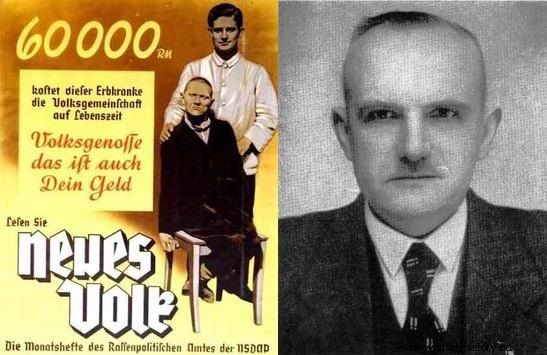All mentally ill were subject to forced sterilization in the Third Reich. Nazi eugenics assumed the complete elimination of "handicaps" from the process of inheritance.
It was July 14, 1933, when Germany passed one of the most immoral laws in history. The Nazis created a special list of hereditary diseases for it. From then on, each person whose condition was mentioned in the act was to be subject to compulsory sterilization. Who did the Nazis say did not deserve children?
"Socially redundant" and "handicapped" will not have children
The new law was intended to cover thousands of people whose ailments were identified as hereditary and endangering the purity and perfection of the Aryan race. First of all, sterilization was to include those with developmental retardation and the mentally ill (including people suffering from schizophrenia and bipolar disorder).

All the mentally ill were subject to forced sterilization in the Third Reich. Nazi eugenics assumed the complete elimination of "handicaps" from the process of inheritance.
The diseases included on the list attached to the act include:blindness, deafness, epilepsy, Huntington's chorea, i.e. a disease manifested by motor and mental disorders and dementia, or the so-called "Congenital idiopathic".
In addition, the act distinguished people with all physical disabilities, i.e. crippled people, who were born, for example, without an arm or had deformed limbs. The Germans also recognized alcoholism as a hereditary disease that should be completely eliminated, and therefore forced sterilization also included addicts. Persons who, according to the Nazis, should not have children were also "socially unnecessary" individuals, i.e. criminals and prostitutes.

The first country in the world to introduce forced sterilization as part of eugenics policies was the United States. Pictured is a poster from a conference in 1921 showing the states that passed the law.
The final decision regarding the sterilization of a specific person was resolved by special district courts (about 200 of which were established in the Reich), composed of two doctors and one lawyer. Anyone who was included in one of the categories listed on the list had to appear in a court trial, in which the accused's entourage was often called as witnesses. All those whose medical information was incomplete faced severe financial penalties.
The task of the new law was to completely eliminate "handicapped" individuals from German society. The goal of this Nazi eugenics was to control human reproduction so as to create a race of ideal people, inheriting only the most perfect traits. During the entire period of the Third Reich's existence, the process of forced sterilization affected almost half a million people . In addition, from 1937, people of "Aryan-African" origin (the so-called Rheinlandbastarde were also subject to it (although they were not formally covered by the law) ).
American-style sterilization
The Third Reich was not a historic pioneer in the field of eugenics. As early as the 18th century, the first publications of German medical professors appeared, who divided people into better and worse. It was also then that the postulate of banning marriages with people burdened with hereditary diseases began to appear.
An interest in selective reproduction developed in the 19th century. Pseudoscientific medical theories were further enriched by the "fathers of racism", such as Joseph Gobineau and Houston Chamberlain. The eugenics movement, however, had its best years in the early twentieth century. It was then that organizations and societies began to emerge, postulating the prohibition of mixing racially different marriages and promoting the forced sterilization of genetically burdened people. Such regulations have been officially introduced in the USA, for example.
One of the first states to pass the new law was Virginia (by 1957, as many as 27 states had enacted compulsory sterilization!). The procedure was performed without the consent, and often even without the knowledge of the victims themselves. To unaware patients, American doctors performed the procedure during routine examinations or during treatment. It was the eugenic laws of the United States that were to inspire the Nazis to introduce the July 1933 provision .
However, this is not all that the Nazis took from American "medicine." In 1935, the Germans passed a law according to which "purebred" citizens were not allowed to marry Jews (you can read more about this issue HERE ). These bans were inspired by those introduced in the US, where the same was supposed to apply to the relationships of the white and black populations. Work on the German project on forced sterilization began a few months after the NSDAP took power. The bill immediately hit Hitler's desk. All it took was a signature now. There could only be one final decision by the Führer.
Nazi eugenics
The author of the act on sterilization in the Third Reich was not any of the "leading" Nazis. It was a little-known NSDAP veteran, doctor Arthur Gütt. As historian Ian Kershaw writes, he was an example of an "outsider in the world of medicine" until the Nazis took power. Everything changed when he was appointed to an influential position in the medical department of the Ministry of the Interior. Gütt fed Hitler with his theories about the "sterilization of the sick and the disabled" in the 1920s. Work on the project from 1933, however, took place without the knowledge of the Führer. This is how Kershaw describes it:
Hitler had nothing to do directly with the law being prepared, which was presented as a boon to both the family and society as a whole . However, when preparing the law, it was realized that it was in line with Hitler's views. And when it was presented to the government, it met with its approval (...).

The author of the sterilization act was none of Hitler's aides, but a little-known NSDAP veteran Arthur Gütt (pictured right). On the left - one of the Nazi propaganda posters, estimating how much it costs the state to support a person suffering from one of the hereditary diseases.
After the law came into force, thousands of compulsory sterilization procedures were quickly carried out. However, not all Germans were convinced of the new law. An objection, immediately after its presentation, was expressed by Vice-Chancellor Franz von Pappen, who represented the Catholic Center. Hitler, however, did not take his protests seriously and approved the law.
Sterilization was carried out in hospitals all over Germany. According to estimates, there have been about 400,000 of them since 1933. Several thousand people died as a result of complications . Across the country, the Germans launched propaganda aimed at justifying forced sterilization. Examples include Nazi posters depicting healthy families or the image of a "full-fledged" German holding two handicapped people on his shoulders.
The whole was supposed to suggest that the Sterilization Act is a necessary factor for the preservation of a healthy and racially clean nation. However, this was not the end of eugenic ideas in the Third Reich. A few years after the infamous 1933 Act, the Nazis took it a step further. Only that these were no longer medical treatments that eliminated fertility, but the regular killing of people considered unnecessary.
From sterilization to euthanasia
At the beginning of 1939, the Reich chancellery received a letter written by a certain Knauer. The content was to be addressed directly to Hitler. In the letter , the sender asked for permission to kill his child, who was born with the underdevelopment of the left foot, without a forearm and one eye. The Führer consented to his killing and this decision was followed by another one. With the approaching war in 1939, Germany introduced the so-called "Grace of death."

The building of the Sonnenstein castle, in the cellars of which several thousand mentally ill were killed as part of the T4 action, consisting in the physical "elimination of life not worth living".
This criminal program, which was called "euthanasia", was to involve the physical liquidation of all terminally ill. The operation was codenamed "Aktion T4", named after Tiergartenstraße 4, where the Euthanasia Organization Headquarters was located. About 70,000 people, most often mentally ill, were killed as part of the action. According to some data, however, these numbers can be much higher .
People destined for death were shot, poisoned or gassed by the Nazis. They murdered a significant part on Polish soil. Despite the opposition of the Catholic Church, the liquidation of the sick in the Third Reich continued until the end of the war. On some of them, criminal experiments were carried out before their death.
Redress
After the end of World War II, victims of forced sterilization had to wait a long time for redress. The case was so sensitive that similar regulations were still in place in the USA, Sweden and even communist Czechoslovakia, where Roma women were subjected to surgery.
For many years, compulsory sterilization was taboo. Historians and journalists rarely mentioned it. Americans apologized for their eugenic laws only in 2001. Germany just a few years earlier, when the parliament in 1998 issued a special statement declaring the forced sterilization of the Nazis unlawful. Nevertheless, the treatments carried out in Germany in 1933-1945 are still not fully discussed subject of the history of Nazi crimes.
Inspiration:
The article was inspired by a new novel by Piotr Adamczyk, " Blonde Farm "(Agora 2018), which is a sensational Polish-German family epic that takes place in Nazi Germany and in today's Poland. Great love, politics, art and betrayal with the specter of Lebensborn in the background.
